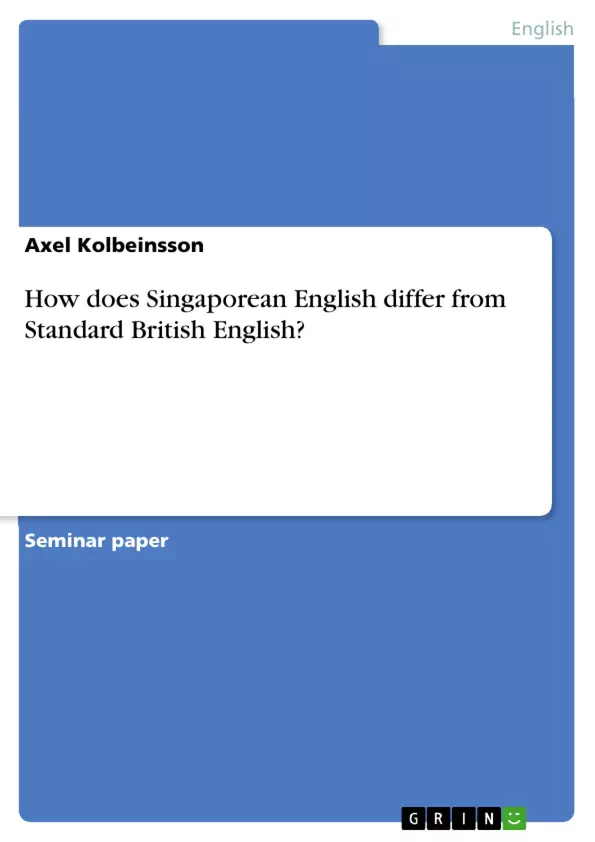Singaporean English is spoken roughly by 4 million people as a postcolonial British English variety. This paper rests on the hypothesis that Singaporean English also underwent such a radical (language) development and differs considerably from Standard British English.
In order to verify the assumption, this term paper analyses the characteristics of this variety and compares it to British Standard English. Firstly, the paper gives a brief overview on how Singapore has come in contact with the English language and how it has developed until now. Then Singaporean English is analyzed in depth in the areas of phonology, syntax/morphology, discourse particles, vocabulary and idioms. In the area of phonology, the Standard British English accent of Received Pronunciation (RP) is used as a reference, as it is the model of reference in terms of pronunciation commonly used in EFL/ESL classrooms and therefore, widely known. In the other areas Standard British English is referred to.
Table of Contents
- Introduction
- History of Singaporean English
- Characteristics of Singaporean English
- Definition
- Syntax and morphology
- Discourse particles
- Phonology/pronunciation
- Vocabulary and idioms
- Conclusion
- References
Objectives and Key Themes
This paper aims to analyze the characteristics of Singaporean English and compare it to Standard British English, testing the hypothesis that Singaporean English has undergone significant development and differs considerably from its British counterpart. The analysis will trace the historical development of Singaporean English and examine its phonological, syntactic, morphological, lexical, and discoursal features.
- Historical development of Singaporean English
- Phonological features of Singaporean English
- Syntactic and morphological features of Singaporean English
- Discourse particles in Singaporean English
- Vocabulary and idioms in Singaporean English
Chapter Summaries
Introduction: This introductory chapter sets the stage for the paper by establishing the context of Singaporean English as a postcolonial variety spoken by approximately 4 million people. It highlights Singapore's rapid socio-economic development and proposes the hypothesis that Singaporean English has undergone a parallel linguistic transformation, diverging significantly from Standard British English. The chapter outlines the paper's structure, which includes a historical overview of English's development in Singapore followed by an in-depth analysis of its phonological, syntactic, morphological, lexical, and discoursal aspects. The use of Received Pronunciation (RP) as a reference point for phonological comparison is justified by its prevalence in EFL/ESL contexts.
History of Singaporean English: This chapter delves into the historical trajectory of English in Singapore, tracing its origins back to the pre-British era of trade and the establishment of a formal connection with Britain upon Sir Stamford Raffles' arrival in 1819. The chapter discusses the sociolinguistic landscape at the time, characterized by a multi-ethnic society with distinct legal and administrative systems. It highlights the British attempt to create an English-educated elite and the subsequent spread of English as a means of socio-economic mobility. The chapter also examines the transition from English-medium schools employing English as a tool for upward mobility and the subsequent development of a colloquial variety at home, heavily influenced by local languages. The influence of the "capitan system," a system of ethnic-based leadership, is explained, illustrating its lasting impact on Singapore's current policy of multiculturalism and the use of English as a neutral lingua franca.
Frequently Asked Questions: A Comprehensive Language Preview of Singaporean English
What is the overall purpose of this document?
This document provides a comprehensive preview of a paper analyzing the characteristics of Singaporean English. It includes the table of contents, objectives, key themes, chapter summaries, and keywords. The aim is to offer a structured overview of the research on Singaporean English and its divergence from Standard British English.
What topics are covered in the Table of Contents?
The table of contents covers an introduction, the history of Singaporean English, a detailed examination of its characteristics (including definition, syntax and morphology, discourse particles, phonology/pronunciation, and vocabulary and idioms), a conclusion, and references.
What are the main objectives and key themes of the research?
The main objective is to analyze the characteristics of Singaporean English and compare it to Standard British English. The key themes include the historical development of Singaporean English and an examination of its phonological, syntactic, morphological, lexical, and discoursal features. The central hypothesis is that Singaporean English has undergone significant development and differs considerably from its British counterpart.
What does the introduction chapter cover?
The introduction establishes the context of Singaporean English as a postcolonial variety spoken by approximately 4 million people. It highlights Singapore's rapid socio-economic development and presents the hypothesis that Singaporean English has undergone a parallel linguistic transformation. The chapter outlines the paper's structure and justifies the use of Received Pronunciation (RP) as a reference point for phonological comparison.
What is discussed in the chapter on the history of Singaporean English?
This chapter traces the historical trajectory of English in Singapore, from its pre-British origins to its development as a lingua franca. It discusses the sociolinguistic landscape, the British attempt to create an English-educated elite, the transition from English-medium schools, and the influence of local languages and the "capitan system" on the development of colloquial Singaporean English. The chapter emphasizes the role of English as a means of socio-economic mobility and its impact on Singapore's multicultural policy.
What aspects of Singaporean English are analyzed in detail?
The analysis delves into the phonological, syntactic, morphological, lexical, and discoursal features of Singaporean English. Each of these features is compared and contrasted with Standard British English to highlight the significant developments and divergences in the language.
What is the overall conclusion likely to be?
While not explicitly stated in the preview, the overall conclusion is implied to support the hypothesis that Singaporean English has significantly diverged from Standard British English due to its unique historical development and sociolinguistic context in Singapore.
- Quote paper
- Axel Kolbeinsson (Author), 2020, How does Singaporean English differ from Standard British English?, Munich, GRIN Verlag, https://www.grin.com/document/1191808



